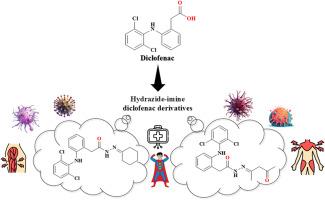Design, synthesis, and pharmacological evaluation of hydrazide–imine diclofenac derivatives with dual anti-inflammatory and anticancer potential
IF 6.3
2区 医学
Q1 BIOLOGY
引用次数: 0
Abstract
Diclofenac, a widely used nonsteroidal anti-inflammatory drug (NSAID), is effective in treating pain and inflammation and has also shown potential as an anticancer agent, primarily through cyclooxygenase-2 (COX-2) inhibition. However, its therapeutic application is often limited by adverse effects, necessitating the development of new derivatives with improved pharmacological profiles. In this study, two novel diclofenac hydrazide–imine derivatives, DDCH (cyclohexanone-based) and DDAC (acetylacetone-based), were synthesized, structurally characterized, and evaluated through combined computational and experimental approaches. Density functional theory (DFT) calculations provided transition-state and energy profile analyses, while molecular docking and molecular dynamics (MD) simulations established stable interactions of both derivatives with COX-2 and heat shock protein 90 (HSP90), a key oncogenic chaperone. DDAC exhibited particularly strong binding to HSP90, suggesting enhanced anticancer potential compared with diclofenac. In silico drug-likeness and ADME assessments, including Lipinski's Rule of Five, predicted favorable pharmacokinetic properties. Experimental evaluation confirmed anti-inflammatory efficacy: in vitro protein denaturation assays showed that DDAC display inhibition comparable to diclofenac, while in vivo carrageenan-induced paw edema studies demonstrated significant activity for both derivatives. Collectively, these findings confirm that DDCH and DDAC retain anti-inflammatory properties while offering predicted anticancer potential, with DDAC emerging as the more promising dual-action candidate. This work establishes a rational framework for the further optimization and pharmacological development of diclofenac-based analogues targeting both inflammation and cancer.

具有抗炎和抗癌双重潜力的肼亚胺双氯芬酸衍生物的设计、合成和药理学评价。
双氯芬酸是一种广泛使用的非甾体抗炎药(NSAID),可有效治疗疼痛和炎症,也显示出作为抗癌剂的潜力,主要通过抑制环氧化酶-2 (COX-2)。然而,其治疗应用往往受到副作用的限制,因此需要开发具有改进药理特征的新衍生物。本研究合成了两个新的双氯芬酸肼亚胺衍生物DDCH(环己酮基)和DDAC(乙酰丙酮基),并对其进行了结构表征,并通过计算和实验相结合的方法对其进行了评价。密度泛函数理论(DFT)计算提供了过渡态和能量分布分析,而分子对接和分子动力学(MD)模拟建立了这两种衍生物与COX-2和热休克蛋白90 (HSP90)(一种关键的致癌伴侣)的稳定相互作用。DDAC与HSP90的结合特别强,表明与双氯芬酸相比,DDAC具有更高的抗癌潜力。在计算机上,药物相似性和ADME评估,包括利平斯基的五法则,预测了有利的药代动力学特性。实验评估证实了抗炎功效:体外蛋白质变性实验显示DDAC的抑制作用与双氯芬酸相当,而体内卡拉胶诱导的足跖水肿研究显示两种衍生物都有显著的活性。总的来说,这些发现证实了DDCH和DDAC保留了抗炎特性,同时提供了预测的抗癌潜力,DDAC成为更有希望的双作用候选药物。这项工作为进一步优化和开发基于双氯芬酸的靶向炎症和癌症的类似物建立了合理的框架。
本文章由计算机程序翻译,如有差异,请以英文原文为准。
求助全文
约1分钟内获得全文
求助全文
来源期刊

Computers in biology and medicine
工程技术-工程:生物医学
CiteScore
11.70
自引率
10.40%
发文量
1086
审稿时长
74 days
期刊介绍:
Computers in Biology and Medicine is an international forum for sharing groundbreaking advancements in the use of computers in bioscience and medicine. This journal serves as a medium for communicating essential research, instruction, ideas, and information regarding the rapidly evolving field of computer applications in these domains. By encouraging the exchange of knowledge, we aim to facilitate progress and innovation in the utilization of computers in biology and medicine.
 求助内容:
求助内容: 应助结果提醒方式:
应助结果提醒方式:


